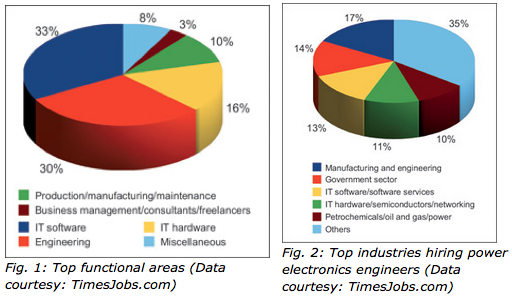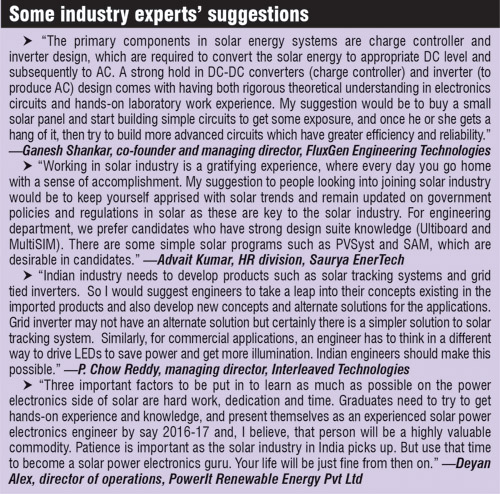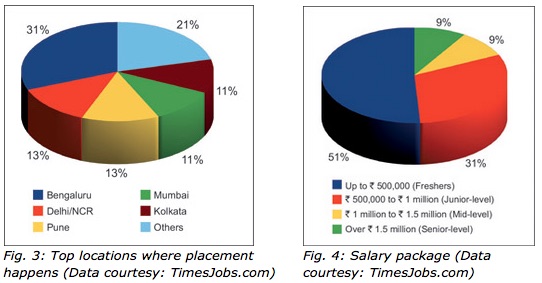Each year our planet receives 5000 times more solar energy than it consumes. Using photovoltaic (PV) technology, it is possible to convert that energy into electricity, thereby helping to solve our present energy challenges.
Let us find out if there are enough job opportunities in the Indian solar industry for engineers with a power electronics background.

Scope
The solar industry is growing in two ways. One is through the new solar power plants and the other is through solar-based products. The first vertical requires a person to be well versed in mechanical design, civil engineering, electromechanical engineering, electrical and, obviously, power electronics.
P. Chow Reddy, managing director, Interleaved Technologies says, “An engineer who has worked in these fields or similar ones can have an opportunity to give his services in the field. But for the second vertical, one having basic power electronics knowledge and experience can only make an entry.”

The scope for a career in power electronics in solar field is immense. “Indians are really good at inverters and UPS. Solar adds a few more skills and expertise into the mix. Anyone who is good at these three or four years from now will be in huge demand, especially when solar hits the mainstream,” says Deyan Alex, director of operations, PowerIt Renewable Energy Pvt Ltd.
“There is an acute shortage of skilled manpower in functional areas such as area site survey, design and engineering, execution, installation and commissioning, operation and maintenance,” informs Chetan Kumar, assistant director, Paawan Energy India Pvt Ltd. For solar PV (SPV) industry, the most preferred backgrounds are B. Tech. in EC/EE/EI/ME.
“Considering the components that go into a solar energy system, after energy storage (that is, batteries), the next most sought-after components are the power electronics circuits required for energy conversion,” informs Ganesh Shankar, co-founder and managing director, FluxGen Engineering Technologies.

“Engineers with strong hold in circuit theory and solid-state electronics are much required to particularly address the reliability and efficiency aspects of power electronics in the solar industry,” says Shankar.
Power electronics is a lucrative field that has application in both smart grid regulation technologies as well as solid-state inverter electronics for the control and conversion of electric power. Energy companies, battery and genset manufacturers, electronics and computer hardware manufacturers, and power generation, conversion and distribution companies look for people with these skills. “Solar energy electronics is still a nascent field and has a great potential for growth in the near future. Currently, it is a highly niche segment, with most people having risen to positions with a strong background in allied power-generation technologies,” informs Vivek Madhukar, COO, Times Business Solutions Limited (which operates TimesJobs.com).
The major share of the jobs available for engineers with a power electronics background is in functional areas such as manufacturing and engineering which constitutes about 17 per cent, followed by IT software sector which provides about 13 per cent and the semiconductor sector with about 11 per cent of the jobs. Around 14 per cent of the jobs are provided by the government.
In terms of geographical locations, apart from Bengaluru being on the top with 31 per cent jobs, Delhi NCR and Pune offer 13 per cent each whereas Mumbai and Kolkata each offer 11 per cent of the jobs.
Opportunities for engineers
Like most electronics design engineering jobs, even in power electronics, fresh engineering graduates are best suited for testing and validation, looking at it from an organisational point of view as well as from an employee point of view, believes Shankar.
Shankar adds, “With the experience of testing and validation, a fresh engineering graduate is more equipped to design and construct superior-quality power electronic circuitry at a later point of time. Having said this, the fresh engineering graduate can very much participate in the design process with senior engineers, which may give fresh perspective to the design team.”
Entry-level roles are mainly going to be on the R&D side of solar and power electronics.
“Most fresher jobs (masters candidates) are either in design or testing department. There is an increasing trend, at least in overseas solar firms, to hire candidates as analysts with a broad job description, where freshers can get a feel of different components before specialising,” informs Advait Kumar, HR Division, Saurya EnerTech.
On a different note, Reddy informs that for a fresher, the solar power plant field restricts the person’s growth. One needs to grow from basics of power electronics to ultimately work on power plants. Whereas in domestic solar products, an engineer will be concentrating at the component-level working on small products, giving the design engineer a picture of how he should behave for the power plants.
Talking about an upcoming field in the solar sector, Reddy says, “The world is working on LED lighting with solar power. This is a right combination for the power-saving LEDs. Engineers need to work further to develop efficient LED driving methods. A young designer, when given a free hand, can always make miracles in the field.”
A graduate or a student with true dedication and enthusiasm for engineering can come from any institute. “For us, we have no such preferences—we are open to all. We have an internship program for undergraduate engineering students who may wish to pursue a career in renewable energy in general and solar PV systems in specific. They can by all means contact us and, based on their drive, we may like to offer them an internship opportunity in our company,” says Shankar.
On a similar note, Reddy says, “I very particularly see the talent, technologies he has worked in, his versatility, adaptability and ability to develop new concepts. An individual with a diploma or masters in engineering may differ in pay but, when it comes to designing the product, I treat them equal. Engineers from IITs/NITs could work in many domains but the solar is still an infant and cannot carry them.”

Pay package
Going by the data provided by TimesJobs.com, package for fresher ranges from Rs. 120,000 to Rs. 180,000 per annum, and experienced professionals get around Rs. 300,000 to Rs. 420,000 per annum. The top roles for jobs are in the engineering and IT sectors, with Bengaluru being a hub of current job demand for junior and mid-level profiles, with starting salaries up to
Rs. 500,000.
However, Advait Kumar informs us that this scale is not fixed everywhere. “It is important to understand that each engineering discipline is very different, and packages for freshers in engineering depend upon a candidate’s area of concentration and level of education. I would say that for a fresher the package can range anywhere from Rs. 150,000 to
Rs. 500,000 per annum.”
Commenting on the pay package, Reddy says, “When it comes to me, I would prefer to take fresh diploma holders and fresh engineers with a pay pack of Rs. 10,000 and Rs. 15,000 per month as a start off in R&D. I believe in training them to the field requirements of designs right from the conceptualisation to the completely shaped product. This helps me in making my design engineers professionally ready to handle new requirements single handedly.”
Skills expected by the industry
Basically, the engineers must be strong in power electronics. A fresh engineer should be well versed with electric circuits (network analysis) and solid-state electronics, and knowledge of advanced power semiconductor devices such as IGBTs, power MOSFETs and UJTs is most beneficial.
A fresher should have an exposure to basic designs of power supplies and power controllers. Understanding of DC-DC converters and recent trends in power conversion is a must. A regular update of the kind of PWM controllers’ availability, and an understanding of new concepts in power switches could be of added advantage.
Similarly, knowledge in concepts of charging algorithms of different types of batteries will take him to a right place in R&D.
Reddy says, “I suggest experienced graduates to concentrate on power distribution, SCADA and electromechanical designs of the domain. As of today, most of the companies are importing the solar tracking systems. This is a simple application and can be indigenously developed.”
He further adds, “Experienced engineers need to work on upgradation of imported ones with respect to basic functions, features, sustainability to climatic conditions and cost control. And, finally, they should be versatile for the adoption of technologies needed to cater to the product.”
“Having the knowledge of electromagnetic compatibility and associated methods to combat it will help in staying compliant with industry standards, which becomes essential while dealing with high-frequency switching power circuits,” informs Shankar.
Future
With ever-rising fuel costs, changing climatic conditions and an ever-growing demand for electricity, renewable energy resources like solar power are becoming an increasingly valuable part of the world’s energy mix.
By utilising our expertise in power electronics, India needs to constantly strive and innovate to develop solutions such as solar inverters, low-voltage and grid-connection products as well as PV power plants that can efficiently transform the sun’s energy into reliable power.
Talking about power conditioning units (PCUs), Deyan says, “It holds great potential in the coming few decades for the Indian solar industry, and that is why we make so much investment and R&D into this. It is a combination of MPPT charge controller and pure sinewave inverter.”
For controlling the cost of a solar products an engineer needs to put the SPV panel to full utility under all conditions in the design stage itself. Today, SPV modules are the backbone of the end product. But the scenario has to change to electronics playing a lead role.
In this regard, Reddy informs, “Updates till date that have come in include MPPT charger. MPPT is an algorithm catering to power for longer period, ultimately reducing the SPV module size and power. This reduces the cost of the SPV module. But, overall, product cost remains the same.” So what is the advantage of MPPT charger with respect to the cost? “I suggest the fresh engineers to churn out new thoughts like boost regulating the power at each SPV module and then stretching its power to the junction box, which could be an answer to that question,” he adds further. So here the skills of power electronics engineer take the lead role.
The current pay packages might not be very promising, but the solar industry has a big future. The window is open for the next 50 or more years.







